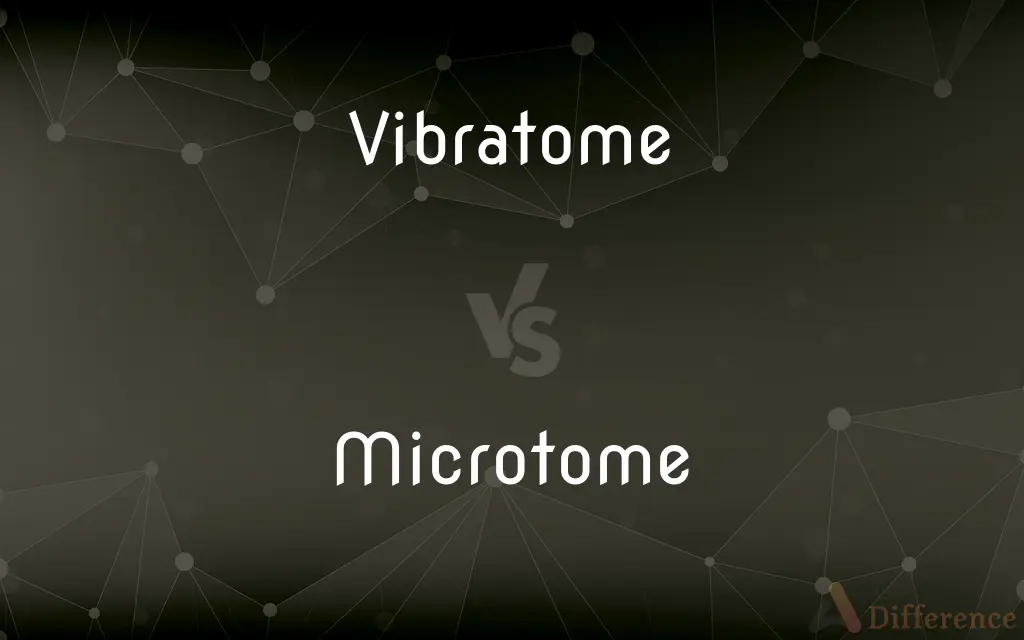Vibratome vs. Microtome — What's the Difference?
Edited by Tayyaba Rehman — By Maham Liaqat — Updated on March 15, 2024
A vibratome cuts soft tissue with vibration for histology, preserving live cells, whereas a microtome slices thin sections of fixed tissue, ideal for detailed cellular studies.

Difference Between Vibratome and Microtome
Table of Contents
ADVERTISEMENT
Key Differences
A vibratome utilizes a vibrating blade to cut through soft tissue, creating sections that are suitable for examinations requiring the preservation of live cells, such as in electrophysiological studies or when staining for certain live cell markers. This method allows researchers to study tissue in a state that is closer to its natural, living condition. On the other hand, a microtome is designed to slice very thin sections of tissue that has usually been fixed and embedded in a medium like paraffin or resin. This process is critical for traditional histological studies, where detailed cellular and tissue structures are examined under a microscope after staining.
The vibratome's cutting technique minimizes damage to the structural integrity of the sample, making it ideal for tissues that are delicate or need to be maintained in a state as close to living as possible. Whereas, the microtome's ability to produce ultra-thin sections, sometimes just a few micrometers thick, is essential for detailed microscopy work, allowing for the observation of cellular details, organelles, and even subcellular components with high-resolution imaging techniques.
Vibratomes typically require less preparation of the sample before cutting; tissues do not need to be fixed or embedded, which can alter or damage delicate structures or enzymes. This feature is particularly advantageous for studies involving enzymatic activity or when the tissue's mechanical properties are of interest. Conversely, microtome sectioning requires extensive tissue preparation, including fixation, dehydration, clearing, and embedding, to preserve tissue architecture and enable the slicing of thin sections.
In terms of applications, vibratome sections are often used in research areas requiring the preservation of the tissue's physiological state, such as neuroscience and developmental biology. Microtomes, however, are more broadly used across various fields of biological and medical research for detailed structural studies, including pathology, where precise cellular and tissue morphology observations are crucial.
The choice between a vibratome and a microtome depends on the specific needs of the research. If preserving the live state of the tissue is paramount, a vibratome is the preferred choice. However, for detailed histological analysis requiring thin sections of fixed tissue, a microtome is indispensable, showcasing the distinct yet complementary roles these instruments play in scientific research.
ADVERTISEMENT
Comparison Chart
Cutting Mechanism
Uses vibration to cut soft tissues.
Slices thin sections of fixed tissue with a sharp blade.
Sample Preparation
Requires minimal preparation; samples are not usually fixed or embedded.
Requires extensive preparation, including fixation, dehydration, and embedding.
Section Thickness
Typically produces thicker sections.
Capable of producing ultra-thin sections for detailed study.
Preservation of Cells
Preserves live cells for physiological studies.
Used for fixed tissues, focusing on cellular and structural details.
Ideal Use
Suitable for studies requiring live cell preservation.
Preferred for detailed cellular and structural analyses in fixed tissues.
Applications
Neuroscience, developmental biology.
Pathology, histology, biological and medical research.
Compare with Definitions
Vibratome
A device that cuts soft tissue with vibration to preserve live cells.
The vibratome enabled researchers to prepare live brain slices for electrophysiological studies.
Microtome
Enables the study of detailed cellular structures.
Microtome sections revealed the cellular architecture of the kidney.
Vibratome
Minimizes sample preparation and damage.
Using a vibratome, scientists cut fresh tissue samples without fixation for immediate testing.
Microtome
A tool for slicing very thin sections of fixed tissue for microscopic examination.
The pathologist used a microtome to prepare tissue samples for cancer diagnosis.
Vibratome
Used in fields where live cell activity is crucial.
Developmental biologists use a vibratome to study organ development in live tissue.
Microtome
Broadly used in medical and biological research.
Microtomes are indispensable in labs conducting tissue pathology studies.
Vibratome
Produces thicker sections suitable for certain analyses.
Vibratome sections were used to study the distribution of neurons in live tissue.
Microtome
Requires tissue to be embedded in a solid medium.
Tissues were embedded in paraffin before sectioning with a microtome.
Vibratome
Maintains the physiological state of the tissue.
The vibratome's slices were ideal for live-cell imaging techniques.
Microtome
Essential for traditional histological studies.
Histologists rely on microtomes for preparing slides of various tissues.
Vibratome
A vibratome is an instrument used to cut thin slices of material (although, usually thicker slices than those cut in paraffin-embedded samples using a microtome). It is similar to a microtome but uses a vibrating blade to cut through tissue.
Microtome
A microtome (from the Greek mikros, meaning "small", and temnein, meaning "to cut") is a cutting tool used to produce extremely thin slices of material known as sections. Important in science, microtomes are used in microscopy, allowing for the preparation of samples for observation under transmitted light or electron radiation.
Vibratome
(cytology) A vibrating microtome used to section soft tissue without freezing
Microtome
An instrument used to cut a specimen, as of organic tissue, into thin sections for microscopic examination.
Microtome
A special instrument that produces very thin slices of plant and animal tissues, for later examination by light microscope or electron microscope.
Microtome
To cut into sections using a microtome
Microtome
An instrument for making very thin sections for microscopical examination.
Microtome
Scientific instrument that cuts thin slices of something for microscopic examination
Common Curiosities
What is a vibratome?
A vibratome is a device that cuts soft tissues with vibration, preserving live cells for physiological studies.
How thin can microtome sections be?
Microtome sections can be as thin as a few micrometers, allowing for detailed cellular and structural analyses.
What is a microtome?
A microtome is an instrument used to slice ultra-thin sections of tissue embedded in a medium, for detailed microscopic examination.
What is the main advantage of using a vibratome for tissue preparation?
The main advantage of using a vibratome is its ability to cut tissue sections without requiring fixation or embedding, preserving the live state of cells.
Why would a researcher choose a vibratome over a microtome?
A researcher would choose a vibratome when the preservation of live cells and minimal sample preparation are required, such as in electrophysiological studies.
Can microtomes cut live tissue?
Microtomes are not typically used for live tissue because they require fixed and embedded samples to produce thin sections.
What types of tissues are best suited for vibratome sectioning?
Soft, delicate tissues requiring live cell preservation, such as brain or organ tissue for physiological studies, are best suited for vibratome sectioning.
Are vibratome sections thicker than those produced by a microtome?
Yes, vibratome sections are typically thicker than those produced by a microtome, as they are designed to preserve the structural integrity of live tissues.
Can a microtome be used for electron microscopy?
Yes, microtomes, especially ultramicrotomes, are used to prepare extremely thin sections of tissue for electron microscopy.
What advancements have been made in microtome technology?
Advancements include the development of ultramicrotomes for ultra-thin sections, automated microtomes for consistent thickness, and cryomicrotomes for sectioning frozen samples.
Are there any tissues that cannot be cut with a vibratome?
Very hard or heavily calcified tissues may be difficult to section with a vibratome and may require prior treatment or a different method like microtome sectioning.
Can both vibratome and microtome be used for the same tissue types?
While both can be used for a variety of tissues, the choice depends on the study's requirements; vibratomes for live cell studies and microtomes for fixed tissue analyses.
How does the choice of instrument affect the outcome of a study?
The choice of instrument can significantly affect study outcomes, as it determines the level of cellular detail visible and whether live cell processes can be observed.
How do preparation techniques differ between vibratome and microtome sectioning?
Vibratome sectioning requires minimal sample preparation with no need for fixation or embedding, while microtome sectioning requires extensive preparation, including fixation and embedding in a medium.
Is one method faster than the other?
Vibratome sectioning is generally faster due to less sample preparation time, while microtome sectioning involves more steps and thus takes longer.
Share Your Discovery

Previous Comparison
Opalescence vs. Turbidity
Next Comparison
Perch vs. WhitingAuthor Spotlight
Written by
Maham LiaqatEdited by
Tayyaba RehmanTayyaba Rehman is a distinguished writer, currently serving as a primary contributor to askdifference.com. As a researcher in semantics and etymology, Tayyaba's passion for the complexity of languages and their distinctions has found a perfect home on the platform. Tayyaba delves into the intricacies of language, distinguishing between commonly confused words and phrases, thereby providing clarity for readers worldwide.













































